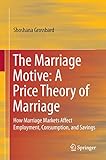The marriage motive : a price theory of marriage : how marriage markets affect employment, consumption, and savings / Shoshana Grossbard.
Material type: TextPublisher: New York : Springer, [2015]Copyright date: ©2015Description: x, 209 pages : illustrationsContent type:
TextPublisher: New York : Springer, [2015]Copyright date: ©2015Description: x, 209 pages : illustrationsContent type: - text
- computer
- online resource
- 1461416221
- 9781461416227
- 306.81 23
- HQ728 .G6675 2015
| Item type | Current library | Call number | Status | Date due | Barcode | |
|---|---|---|---|---|---|---|
| E-Resources | Main Library E-Resources | 306.81 G878 (Browse shelf(Opens below)) | Available | E000630 |
Browsing Main Library shelves, Shelving location: E-Resources Close shelf browser (Hides shelf browser)
Includes bibliographical references.
Introduction -- Part I. A Model of Work-In-Household with Privately Consumed Household Goods -- A Theory of Allocation of Time in Markets for Labor and Marriage: Macro Model -- A Theory of Allocation of Time in Markets for Labor and Marriage: Multiple Markets for Work-In-Household -- Part II Labor Supply and Other Time Uses -- How Marriage Markets Affect Allocation and Valuation of Time Implication from a Macro Model -- Compensating Differentials in Marriage Markets and More New Implications for Labor Supply Based on a Marshallian Marriage Market Analysi -- Revisiting Labor Supply Effects of Sex Ratios, Income, Wage. Effects of Marriage-Related Laws -- Labor Supply, Household Production and Common Law Marriage Legislation -- Labor Supply and Marriage Markets: A Simple Graphic Analysis with Household Public Goods -- Household Production and Racial Intermarriage -- Part III. A Consumption Theory with Competitive Markets for Work-in-Household -- Savings, Marriage, and Work-in-Household.
While this book contains numerous facts and empirical findings and touches on policy issues, its main contribution to the existing literature lies in the theoretical perspective it offers. The core of this book is a general equilibrium theory of labor and marriage presented in Chapter 2, which provides the conceptual framework for the rest of the chapters. Two major implications of the theory are sex ratio effects and compensating differentials in marriage. The book demonstrates how a few core concepts, linked via economic analysis, help explain a multitude of findings based on statistical analyses of data from a wide variety of cultures. It is hoped that readers of this book will improve their understanding of how marriage works to help us design better economic and social policies as well as help people live better and happier lives, making the book of interest to not only economists but sociologists and anthropologists as well.
There are no comments on this title.







